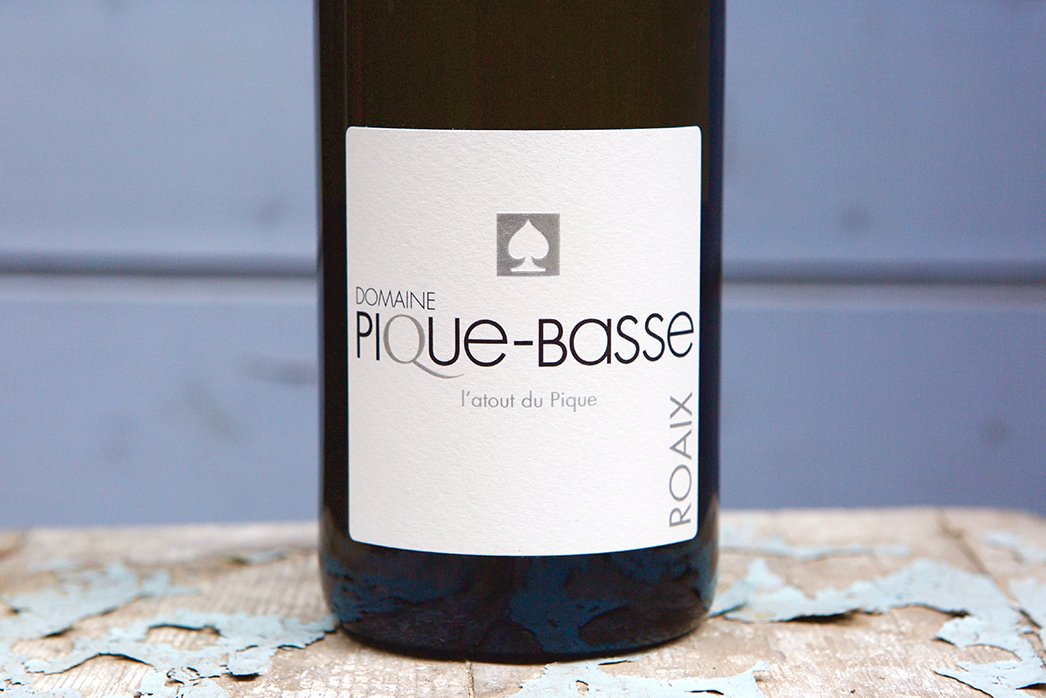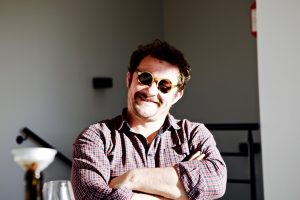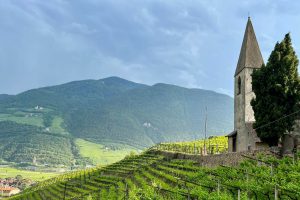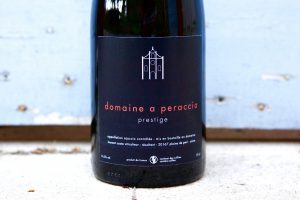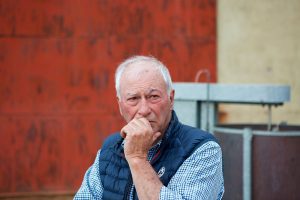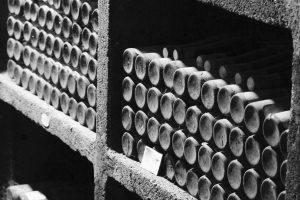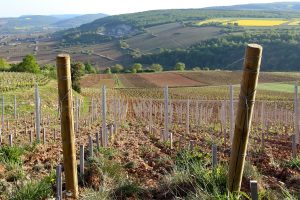Süditrol’s St. Magdelena vines shot from Fliederhof winery, May 2022
May, Europe’s new summer month…
As we descend upon Germany via train from Milan through the Alps, our group of four are all wounded and bloated from a massive intake of beef tartar, vitello tonnato, agnolotti, ravioli, gnocchi, and a near overdose of Nebbiolo (if that’s possible… well, maybe it is with the tannins of young ones…). We are in Germany for a day and then I’m off to Iberia for two more weeks of visits with another group of our staff who are joining me there as the others head home.
I packed light for this forty-day bender, as sparingly as I ever have for a journey of over a month: four pairs of pants, two sweaters and a long jacket have taken up precious space in my bags since I left Prague at the end of April. It’s strangely hot this year and especially dry too. Climate change is really starting to weigh heavily over here and everyone’s concerns are more heightened than ever, despite 2021’s colder year in many locations, with great losses in some areas due to mildew pressure. In the past, climate change was a talking point in the midst of each vintage’s woes, but today, perhaps elevated by the post-pandemic shutdown period (hopefully post!), Ukrainian invasion and inflation ridiculousness, the mood is heavier than ever, especially after so many years of wackiness with the twisting of seasons. In many parts of Northern Italy it has only rained three times since November and what has arrived didn’t deliver enough. We just left Barolo and Barbaresco and many of the Nebbiolo vines were already flowering in those areas and their surroundings, around May 20th, which means a harvest will likely be in early September. There isn’t anything to do except hope for some relief, but it’s already quite late to slow things down enough to extend the season.
I started the trip with ten days in Austria and the Czech Republic accompanied by my wife, Andrea, where we found the best Napolitana pizza I’ve had outside of Campania, at Pizza Nuova (which has a fabulous Italian wine list too), and a great wine bar, Bokovka, both owned by the same clever company. When Andrea left, JD, our Los Angeles sales rep, arrived. After a great visit with our Austrian team—all highlights, honestly, between Tegernseerhof’s 2019s, Veyder-Malberg’s 2021s, Malat’s 2019s and 2021s, Weszeli’s 2017s, and Birgit Braunstein and her cool range of progressive and well-made, biodynamic natural wines—he and I jumped down to Milan to grab Victoria, my sister and Office Manager, and Tyler, an Aussie expatriate who represents us in San Diego and Orange County. We all have serious farmer tans now just in time for the real summer months and big setbacks on our beach bellies.
There is far too much to say about my trip here, and I wish I had time to share it all. What I can say is that I am very proud of the producers we represent in Austria and Northern Italy. Perhaps the biggest surprise for our team was the quality of wines coming from our four producers in Monferrato: Crotin keeps nailing it with inexpensive but serious wines and some new bottlings, too; Spertino is becoming a problem because the international demand for this true vinous artist is putting a pinch on our allocations; La Casaccia, a new producer for us, was probably the most unexpected knockout visit for our group with their masterfully crafted range of Barbera, Grignolino and Freisa (the latter is simply inconceivably delicious, perfumed, and subtle but generous as any Freisa I’ve ever had); and Sette, a new winery working biodynamically that lived up to my hype for my staff with their head-turning wines from Nizza. Alto Piemonte and Langhe also had a spectacular showing with the most notable highlights being Monti Perini’s yet-to-be-bottled 2017, 2018 and 2019 Bramaterra wines, Davide Carlone’s upcoming 2020 entry-level wines all grown in Boca, Dave Fletcher’s 2019 four Barbaresco bottlings that were simply a stunning breakthrough for him (an already very good, young winegrower) and Poderi Colla’s 2019 Barbaresco Roncaglie, a true masterpiece and unquestionably the top Barbaresco I’ve had from them. There’s so much more to add, but we’ll get there another day because now we’re off to Spain and Portugal. In next month’s Newsletter, I’ll give the play-by-play and note the highlights from my final two-week leg of the journey.
New Producers
In June we have a real boatload of wine coming in (unapologetic pun intended). It’s hard to know where to start because there are so many good things arriving. All the new wines this month are from France, except a lone Spanish wine made from one of our new French producers who plays by his own rules, Imanol Garay. Also arriving in the warehouse are new wines from Arnaud Lambert, Thierry Richoux, David Moreau’s 2019s, finally the 2020 Dutraive wines, Francois Crochet’s 2021 Rosé of Pinot Noir, Domaine du Pas de L’Escalette, Pascal Ponson “Prestige Cuvée” Champagne, and finally a reload from our lone Bordeaux producer (for the moment), Cantelaudette. Because there is so much, I’ll only highlight a few, starting with our newest additions.
Aside from the two new producers we will explore today, there are over a dozen more we signed on with over the last six months or so whose wines will finally be arriving by the last quarter of the year. We have new wines coming from Chile (Itata), Saumur, Montlouis, Champagne, Bordeaux, Piemonte, Abruzzo, Douro, Setubal, Alentejo, Azores, Rías Baixas, Ribeira Sacra, and Sicily—finally, after five years of poking around the island.
We are in the middle of exciting times at The Source and we greatly appreciate the support from you who continue to work with our talented team and consider the wines from our constantly evolving portfolio. It’s because of you that we can continue to do the work we love to do.
Imanol Garay, Southwest France/Northern Spain
Spanish/French former engineer and barrel broker, Imanol Garay, un vigneron libre, follows no wine rules (other than some labeling requirements for his French/Spanish wine blends) and believes in terroir not only as the concept of specific site or even region but as a contiguous philosophical thread practiced in different places that may be forged into one wine. A resident of southwest France, his cellar is in Orthez, only a short drive from Spain’s Basque country. Before starting his project, he worked with French natural wine gurus Richard Leroy and Vincente Careme, among others. Some vineyards are his own, some he rents and farms, and some fruit comes from friends with the same deep respect for nature aligned with their life philosophy. He has another project in Spain’s Txakoli region with friends, Alfredo Egia (also in our portfolio) and Gile Iturri, labeled Hegan Egin; some years he makes Rioja, others Navarra, and always a lot of French wine. Cautiously walking the natural-wine line, his pursuit is of the clean yet uninhibited, void of unwanted animally smells (the mouse, the horse), and instead with wonderful character-filled and potently nuanced, high-energy wines filled with joy and authenticity, like the man himself.
Imanol Garay
We start with Imanol’s 2020 Clandestinus, a Pyrenean red wine from Spain’s Navarra grown on limestone bedrock with brown topsoil. CLANdeSTINUS is a play on words regarding Imanol’s family history, the Stinus clan, from (de) Alsace in former times, and a “tribute to all those who have crossed mountains, seeking a better life.” The mix is equal parts Grenache and Graciano, the latter a less well known and very promising red variety with an incredible structure led with, at times, jarring acidity when not fully ripe, but gorgeously savory with tight dark red fruit. As all of Imanol’s wines, it’s made without any additions throughout vinification, with some added after malolactic fermentation where it receives a sparse amount of sulfur prior to bottling. Élevage takes place over a ten-month period in a mix of 228-, 600- and 700-liter French oak barrels with mostly old wood and a small portion of new. Clandestinus dances on its toes around the danger of a natural wine disaster while delivering a non-stop barrage of juicy, slightly baked fruits and roasted nuts, and sweet, northern Spanish countryside rusticity—think leather, chestnuts, and cured meat. I observed this young and surprisingly voluptuous wine for days after opening it, waiting for it to succumb to exhaustion after its vigorous dance, but my wife fell under its spell and finally finished it off before I could stop her—a surprising act from someone who usually has little interest in red wines that hit 14% alcohol.
Diving into Imanol’s highly sought after whites with unfortunately extremely tight limitations on quantity are his Ixilune (pronounced “itchie-loo-nay”), French whites grown in and around the Madiran and Béarn appellations, without the appellations on the labels. These are very special whites indeed, and we took whatever Imanol would allow from the two vintages available. Both are deep in reductive, minerally elements (à la Richard Leroy) and need a moment to open and express their rolling hill, limestone and alluvial terroirs.
The 2018 Ixilune is composed of 70% Petit Courbu from d’Aydie, and 30% Petit Manseng from Soublecause. The élevage takes place in 225- and 500-liter barrels of young but no new French oak. Free of sulfites through its time in wood, a first and final addition was made at bottling. The 2020 Ixilune is a blend of 25% Petit Courbu and 25% Petit Manseng (both from Pacherenc du Vic-Bilh), with the difference, a rare white grape with a long tradition, Raffiat de Moncade, cultivated in and around the village of Orthez. The potentially high-yielding Raffiat de Moncade produces relatively neutral white wines, often expressing soft, white flesh fruit notes and flowers. It offers this blend with the other two higher-toned and more tense fresh grapes a gentler mouthfeel and softer aromas. The 2020 Ixilune is similarly aged in 225- and 500-liter barrels of young French oak and 10% in a small amphora. Always searching to work around sulfur, Imanol was confident enough to bottle this white without adding any. Given his successes with his no-sulfur Txakoli project, Hegan Egin, the 2020 Ixilune appears to follow in those very successful footsteps. Both wines are 14% in alcohol, but fresh, tight, minerally (alongside its beautiful reductive elements) and as mentioned, surprisingly unbreakable for days after opening.
New Producer: Nicolas Pointeau (Domaine de la Sablière), Chinon
Due to the severe shortage of Saumur red wines from Arnaud Lambert, Romain Guiberteau and Brendan Stater-West, I began to search for some young blood in the Loire Valley’s Cabernet Franc world, especially outside of Saumur, to add a little variety to our Cabernet Franc range. I love the wines of Saumur, but I’m also interested in finding other things throughout the rest of the Loire Valley, a region we adore.
Marielle et Nicolas Pointeau
I received a tip from one of our top winegrowers about the wines of Nicolas Pointeau, a young vigneron working his family’s Chinon winery organically with his wife, Marielle, in Domaine de la Sablière. Any tip from great producers is worth exploring, and a few years ago they met Nicolas at an event and pointed me in their direction—this is how “discovery” in importing works most of the time (nearly all the time), rather than knocking randomly on doors and cold-calling in other ways.
A lot has happened between my introductory tastes of his wines in the summer of 2019, with the 2017 and 2018 vintages, and what is in the bottle now, with the 2020 vintage. The conversion to organic farming and a few more years of experience in the cellar, Nicolas made wines convincing enough to jump on his wagon.
Pointeau’s organic Chinon vineyards on alluvial soils used for the entry-level Chinon wines
Nicolas’ wines will not yet revolutionize the Cabernet Franc wine scene because they are made in a very straightforward way without much “hand in the wine.” His entire range is solid, unpretentious, and not over-thought or overplayed; they deliver tremendous value and exist squarely in the realm of lightly structured, delicious, gravelly, black earth, lovely red and dark-fruited, perfectly ripe and deliciously savory Cabernet Franc. Their vineyards in Chinon are largely on alluvial soils with some on shallow topsoils above tuffeau limestone bedrock. The alluvial soils make for wines with a little more gentleness on acidity and palate roundness without being too rich from the soil and much less solar powered than Cabernet Franc wines from further south in western France. If you are familiar with Arnaud Lambert’s range (as are most restaurant and retail buyers who work with our portfolio), think Les Terres Rouges, or Montée des Roches, both grown on Arnaud’s richer soils of the Saumur-Champigny commune, Saint-Cyr en Bourg, but maybe a little less dense given the loamier soils than the clay-rich soils of Saumur-Champigny. Even more, Nicolas’ reds represent his conviviality and hard-working nature; when I drink them, I am always reminded of him in his well-worn vigneron’s clothes, with a smile from ear to ear.
The Pointeau cellar
Within the range of the three Chinon reds that will land, the 2020 Chinon “Tradition” is the first in line and raised in only stainless steel tanks and comes from gravelly soil on large terraces. The wine does indeed have gravelly textures (classic for the variety), a good mix of dark and red fruits, graphite palate and nose, on a light frame. The 2020 Chinon “Tonneliers” is raised in old French oak barrels (called fûts de chêne in these parts, rather than barrique) and similarly grown on gravel soils as the “Tradition” bottling. The difference here is maybe just a slightly fuller body and rounded edges though with a similar fruit profile. The time in wood also imparts more savory notes and a slight softening of the fruit notes. The 2020 Chinon “Vieille Vignes” comes from parcels with a greater tuffeau limestone presence, further uphill from the vineyards used for the other bottlings we imported. Finer lines and a deeper core with additional mineral notes alongside the variety’s ubiquitous graphite notes, this stainless-steel-aged Cabernet Franc has great purity and depth for Nicolas’ gentle and easy style. The average age of vines for all the cuvées is around forty-five years, with the Vieille Vignes closer to eighty. All the Chinon red wines we imported from Pointeau are bottled between March and June after their vintage year.
New Arrivals
Richoux, Irancy
We have a fabulous group of wines coming in from Thierry Richoux and his fils, Gavin and Félix. The baton is in the process of being passed from Thierry to them, which explains why some labels display their names, and others have Thierry’s. Since 2017 a few things have changed at this organically-run domaine. The boys have incorporated some new techniques, most noticeably a gentler extraction and the use of smaller barrels, where in the past they were aged exclusively for a year in stainless steel, followed by another year in large foudre between 55hl-85hl capacity. They are also experimenting with notable success with smaller total sulfur additions and holding out on the first addition until the wines are ready to be bottled. Much of these changes will be felt in the years to come more than those that arrive today. We adore the old-school style of Thierry and hope they will stay close to it, but it’s obvious that Gavin and Félix are making a few advancements instead of experimental setbacks.
Félix, the youngest of Thierry and Corine Richoux’s sons
We have a reload of 2017 Irancy and our first batch of 2017 Irancy “Veaupessiot”. This vintage expresses the beautiful fruit nuances of this warm vintage that ripened when the fruit was still dominated by red tones. In the 2005 vintage, Veaupessiot became Richoux’s first single-cru bottling of Irancy, and for good reason. While a good portion of Irancy sits inside the amphitheater shape that surrounds the ancient village, there are many prized sites just outside of it, or on the south-side of the south hill of the appellation. Veaupessiot is on the outside, at the southwestern end of the horseshoe-shaped appellation as it opens toward the west. The slope is moderately steep and ends near a ravine that cuts in below it, and an incline far too steep for vineyards. Other vineyards look like they could be as good, but that’s the fun and mystery of great vineyards; it’s not what’s above that determines the great sites, it’s what’s below. Richoux recognized this early on and it remains the most well-balanced single-cru wine in his range. This wine will have good moments early on but certainly has the chops to age as effortlessly as Richoux’s many wines have time and time again. The Richoux family’s wines are bulletproof and remain one of the greatest deals still to be had in all of Burgundy among top domaines.
Richoux Veaupessiot parcel to the left of the road
Les Cailles is Richoux’s second single-cru bottling and is more powerful and structured than Veaupessiot. It’s spicier, more mineral and with more formidable tannins, requiring extra time in bottle as well as aeration once opened to find its peak moment. When it gets there, it arrives in a big way, but we must be more patient than with Veaupessiot. 2015 Irancy “Les Cailles” will surely be the best yet put to bottle (that is released), and this year is a perfect vintage with its boosted ripeness and softer tannins; this means that it will require of you less patience to find its moment upon opening compared to the previous three releases. (The first year of Les Cailles was bottled in 2012.) The 2015 Veaupessiot is an extraordinary wine (that sold out in a flash), which means that Les Cailles will be nothing short of impressive for decades to come. It will be interesting to see Veaupessiot and Les Cailles duke it out over the years, and it would be best not miss a vintage from either of them to experience this intriguing comparison. Les Cailles is situated on the north hill of the amphitheater facing south. The vines are over seventy years old and contribute added depth.
South-facing old vines of Les Cailles
Arnaud Lambert, Saumur
Yet another group of wines from Arnaud Lambert is arriving. We have a lot of coverage of his wines in our newsletters and on the website, so I won’t take a deep dive here. On the boat are reloads of the Crémant de Loire Blanc & Rosé and some new releases of single-cru wines.
It seems we have some of our barrels marked in Arnaud’s cellar!
In the Saumur Blanc department, we have the 2020 “Les Perrieres”, 2018 “Bonne Nouvelle”, 2018 “Coulee de St. Cyr”, 2018 Clos de la Rue, and the 2018 Saint-Just “Brézé”. Quantities are minuscule on some of these, so please go easy on us if we can’t fill your requests. In the red department, the new release of 2019 Saumur “Montée des Roches” and 2018 Saumur-Champigny “Clos Moleton” will arrive. Quantities on these two wines are very limited, so get ahead on those and reach out soon if you are interested.
Brézé’s tuffeau limestone diversity from stark white to light orange due to a higher iron content
Jean-Louis Dutraive, 2017
Dutraive, Beaujolais
Finally, the 2020s from Dutraive will arrive. We opted to wait until all the wines were ready in this vintage (some fermentations ran a little later than expected) before we brought them in, which resulted in some unexpectedly lengthy delays. The 2020 vintage was relatively uneventful and without demoralizing natural elements such as frost or high mildew pressure. However, it was a warm year all around. The difference between some of the other warmer seasons of late is that the vines had a good natural yield that was only curbed by the summer heat, concentrating grapes and making for riper wines. The most positive element of the year was that the growers were able to choose when they wanted to pick, resulting in balanced fruit. Dutraive’s wines in 2020 are fresher than many of the recent years thanks to the naturally balanced crop load. The recent warm years that had early season losses to nature’s elements affected the final balance of the wines due to too much of the vine’s focus on the little quantity of fruit they produced. As usual, quantities are very limited.
Dutraive’s Clos de la Grand’Cour vineyard in Fleurie
Pas de L’Escalette, Languedoc
Julien Zernott and Delphine Rousseau have become one of the Languedoc’s leading producers for substantive wines with higher tones and greater freshness than the typical wines from this massive area of France. During the pandemic many producers were understandably forced to seek out new markets for their wines while their traditional markets, including France, waited out the pandemic. That, in conjunction with the rest of the world taking notice, is why our allocations are more limited these days. I apologize in advance for an unusually small quantity of wines from this young (still!) and progressive duo.
Escalette vineyard with walls constructed from “clapas”
2021 should be a great year for French rosé. It’s probably the coldest year since 2013 and offers a lot of freshness to the wines, especially after the long string of warm years, particularly between 2017 and 2020. Escalette’s 2021 Ze Rozé is a slightly top-heavy wine sourced from some of the better red grape parcels—no specific parcels are isolated for the rosé. Here, compared to most Provencal rosés similarly composed of Grenache, you can expect more body but on a rather tight frame due to the higher altitude, rockier limestone bedrock and topsoil, and the constant fresh winds that blow through this narrow valley. The blend this year is 65% Grenache, 20% Carignan for greater flesh and deeper fruit, 10% Cinsault for more lifted and floral aromas and 5% Syrah.
The 2021 Les Petits Pas also benefited greatly from the cooler year, yielding a very fresh red. From the moment the Les Petits Pas was created, Julien and Delphine’s intention was to add a charmer in their line of wines that didn’t take itself too seriously—hence the full color pinkish red label with neon green, baby footprints. Pas de L’Escalette is nestled up into an ancient roadway that connects the Languedoc to the north by way of France’s central mountain range, the Massif Central. This is cooler wine country, far from the Mediterranean, so it’s plenty cold at night, even in summer, and this is what imparts their wines with more zippy freshness and crunchy red and dark fruits, which make it a perfect wine for warm weather. Les Petits Pas is a multi-parcel blend from organically farmed vineyards on limestone terroirs, typically a mix of 40% Grenache, 40% Syrah and 20% Carignan. Each of these grapes naturally carries ample freshness, magnified by a little chill, making it anything but heavy on a sunny day. It is indeed compelling for us wine geeks, but it’s more of a drink-it-don’t-think-it wine. Les Petits Pas doesn’t constantly tug at your sleeve begging to show you how good it is, it’s just good.
Les Clapas Rouge, named after the limestone rock piles (clapas) found in the vineyards, is led by Syrah, which makes up 50% of the blend. The Syrah is entirely vinified in whole bunches, and Delphine says they never destem Syrah because the stems add so much complexity; they’re mixed in for the fermentation and contribute what one might expect: heightened freshness, texture, and exotic green, animal nuances. The remainder is a mix of 30% Carignan and 20% Grenache, both co-fermented with 50% whole clusters. The latter two grapes contribute more of the suppleness, but the combination of the three—all extremely noble grapes—make for a wine broad in dimension and full in flavor. After its three to four week “infusion” fermentation (which simply means no big movements for extraction) the wine is polished up over fourteen months in 50-hectoliter upright wooden tanks and a single 20-hectoliter foudre. It’s racked once in the spring and the only sulfite addition (no more than 30mg/l, or 30 parts per million of total SO2) is made just prior to the bottling, without any filtration.
